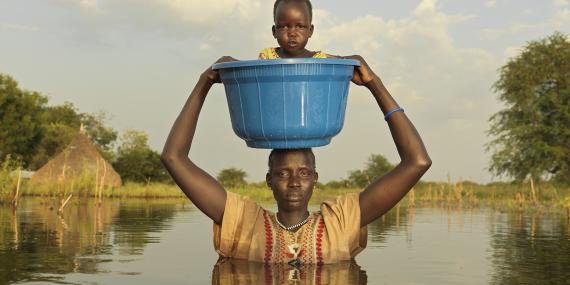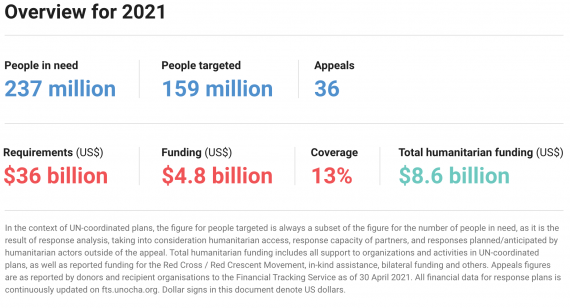South Sudan
A mother carries her daughter to dry land. “We make a sacrifice to bring our children to safety using a bucket”. Action Against Hunger/Peter Caton
The Global Humanitarian Overview (GHO) for 2021 was launched on 1 December 2020 to help 160 million of the 235 million most vulnerable people who face hunger, conflict, displacement, the impacts of climate change and the COVID-19 pandemic in 56 countries. As of 30 April, adjusted requirements were $36 billion to assist 159 million of the 237 million people in need in 56 countries. No changes to requirements or the people in need and people to receive assistance were registered since the last GHO update.
Recorded funding for the 2021 GHO was $4.77 billion or 13 per cent of requirements at the end of April. This is a large increase since last month when reported funding was only $1.61 billion. This increase is in part due to the large number of funding reports received from donors and recipient organisations this month. An additional $3.81 billion of humanitarian funding has been reported.
Inter-Agency Coordinated Appeals: Overview for 2021
Funding gap at end-April (2017-2021)
Humanitarian funding (at end-April, 2017-2021)
Humanitarian needs (at end-April, 2017-2021)
Gender-Based Violence Prevention and Response
In 2021, $513.2 million of requirements have been identified in 26 plans. As of end April, funding against these totaled $21.8 million. An additional $26.5 million for GBV has been reported at the global level, and is yet to be attributed to specific plans and countries.
Organizations receiving funds for GBV activities are strongly encouraged to report them directly to FTS at fts@un.org.
-
More than 34 million people across the world risk falling into famine or famine-like conditions without immediate life-saving action. Over 8.5 million of them live in Burkina Faso, north-east Nigeria, South Sudan and Yemen. In South Sudan and Yemen, 155,000 people are already living in famine-like conditions. The vast majority of people suffering – some 60 percent - are women and children living in rural areas.
Acute hunger levels and famine conditions are caused by a combination of factors. These include conflict, extreme weather and climate shocks, transboundary pests and difficulties reaching people in need. The severe economic slowdown linked to the COVID-19 has also had a severe impact on lives and livelihoods and is likely to linger into the second half of 2021 in many countries.
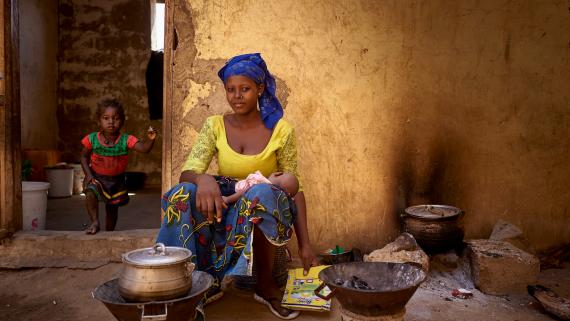
Gao, Mali
A displaced mother with her baby and daughter prepares some food at the camp for people who fled Mondoro, in Gao.
OCHA/Michele CattaniFamine can be averted but this requires swift, concerted international action. Funding is needed before the main planting season that is about to begin in many places and to give enough time to get food to remote areas. In March, the UN Secretary-General has convened a High-Level Task Force on Preventing Famine in 2021. It will focus on three things: advocating for famine-prevention resources; advocating for improved access to people in need; and joining up efforts to share data and real-time information. This work will draw on the collective efforts of Inter-Agency Standing Committee members in each of these areas.
Urgent funding is required in Burkina Faso, north-east Nigeria, South Sudan and Yemen to stop famine from taking hold in 2021. Humanitarian workers will use this funding to urgently scale up food, cash and vouchers. Support to farmers and herders also needs to increase, with a focus on providing early maturing seeds ahead of the main planting season, and keeping livestock fed and healthy. These interventions will be accompanied by nutrition support and health and water services, as starvation-related diseases and untreated illnesses put people at further risk of death. Targeted protection and shelter activities, as well as support to specific refugee and migrant groups, are also key.
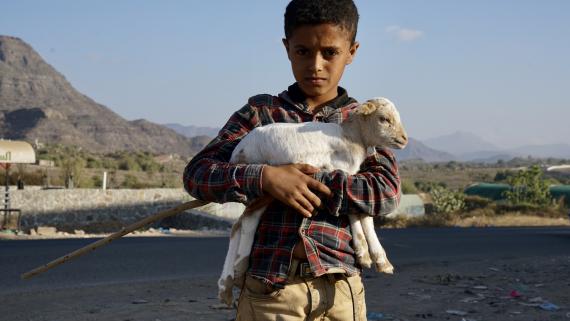
Taiz Governorate, Yemen
A boy holds a baby goat in the rural region of the Taiz mountains, in southern Yemen.
OCHA/Giles ClarkeIn Burkina Faso, more than 80 per cent of people in need of humanitarian assistance will experience crisis or worse levels of food insecurity (IPC/CH Phase 3 or above) from June, including 344,000 people who will be at risk of death from hunger and forced to sell their possessions to survive (IPC/CH Phase 4). Three out of four of those people live in the regions most affected by insecurity: Centre-Nord, Sahel, Est and Nord. And over one million are internally displaced and live in precarious conditions having fled violence. Resource requirements for the 2021 HRP are $608 million to support 2.9 million people.
North-east Nigeria has reached alarming levels of food insecurity and hunger after 11 years of conflict. Four out of five people require humanitarian assistance and protection. Up to 4.4 million people are projected to face critical food shortages (IPC/CH Phase 3 or above) during the lean season (June - August 2021), including 775,000 people at risk of death from hunger and forced to sell their possessions to survive (IPC/CH Phase 4). The 2021 HRP is seeking over $1 billion to support 6.4 million people.
South Sudan is facing its highest levels of food insecurity since the country declared independence ten years ago. An estimated 7.2 million people - 60 per cent of the population - are facing a critical lack of food (IPC/CH Phase 3 or above), including 2.4 million people in emergency levels (IPC/CH Phase 4) and 108,000 people in hard-to-reach areas of six counties who are currently facing catastrophic food insecurity (IPC/CH Phase 5). The continuing impact of the economic crisis which was exacerbated by the COVID-19 pandemic, funding shortfalls and insecurity continue to hamper operations. Resource requirements for the 2021 HRP are $1.68 billion to support 6.6 million people.
In November 2020, the United Nations issued a warning that Yemen was in imminent danger of the worst famine the world has seen for decades. Half the Yemeni population - 16.2 million people - is projected to face a critical lack of food (IPC/CH Phase 3 or above), including five million people are at risk of death from hunger (IPC/CH Phase 4) and 47,000 already facing famine-like conditions (IPC/CH Phase 5). Acute malnutrition is projected to affect 2.3 million children under the age of five in 2021, the highest level recorded since the conflict began. The 2021 HRP is seeking $3.85 billion to support 16 million people.
Evolution of HRP funding coverage (2017-2021)
Anticipatory action
Severe food insecurity is often predictable many months before humanitarian needs escalate, especially when there are climatic factors. Anticipatory humanitarian action can significantly help to avert famines and severe food insecurity. Acting on predictions can mean earlier, faster, more cost-effective response that is more dignified and protects development gains. It also provides opportunities to work more collaboratively between humanitarian and development actors.
OCHA facilitates a dozen collective anticipatory action pilots across the globe. For instance, activating the anticipatory approach in June last year, CERF provided funds to avert a food crisis in Somalia and, acting ahead of the triple impact of locusts, floods and COVID-19, to reduce disease outbreaks, including acute watery diarrhea, malaria and severe acute respiratory infections. As boreholes were upgraded early, household finances improved, mental health was boosted, livestock stayed healthier, disputes related to water sources decreased, and displacement was mitigated. Early action mitigated adverse impact of multiple shocks for almost 640,000 vulnerable Somalis. Similarly, the anticipatory action plan in Ethiopia was activated in December 2020 and CERF is funding interventions like smart agricultural and livestock support to mitigate the impact of a projected La Niña-induced drought in various locations in the Southern Nations, Nationalities, and Peoples’ region of Ethiopia.
Triggering pre-agreed anticipatory action plans and prepositioned financing before humanitarian crises develop is more important than ever. Bringing forecast-based systems to scale requires partnerships and financing to ensure that food security shocks do not push more people into famine.
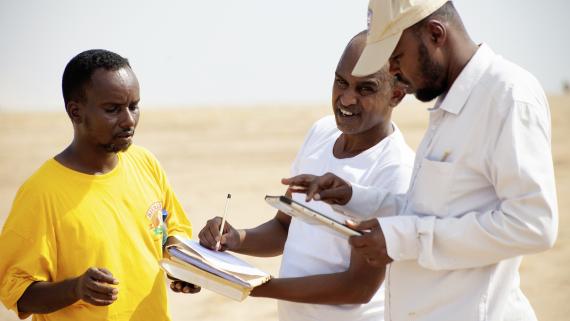
Ceel-Gaal, Somalia
Members of the Somali Ministry of Agriculture on a locust-monitoring mission. “The first time I saw the locusts was when it rained. They have now been here for one month. They have eaten a lot of grass and we have nothing to prevent the damage.”
FAO/Isak AminIn April 2021, the Emergency Relief Coordinator (ERC) allocated $22.5 million from the Central Emergency Response Fund’s rapid response (RR) window.
RR allocations include $15 million to Afghanistan in response to increased humanitarian needs due to the compounding impacts of COVID-19, conflict and drought-like conditions; $5 million in support of people displaced by clashes in the town of Palma in Mozambique; $1.5 million for refugees arriving in the Democratic Republic of the Congo (DRC) from the Central African Republic (CAR); and $1 million in response to the eruption of La Soufrière volcano in Saint Vincent and the Grenadines.
CERF Allocations
CERF allocates $5 million in support of people displaced by clashes in Palma, Mozambique. ERC Lowcock allocated $5 million from CERF for an urgent response to new displacement in Palma in Mozambique’s northern province of Cabo Delgado. On 24 March, the town came under attack by non-state armed groups. In the days that followed, heavy fighting led to displacement. According to IOM’s displacement tracking matrix, by 22 April 2021, nearly 26,000 people had fled Palma and hundreds continued to leave each day. An unknown number were still trapped inside Palma and nearby areas. The situation is also dire for those who remain, as Palma is effectively cut off. Roads are impassable due to security constraints and the rainy season, commercial air traffic is halted, and boat rides have been stopped for civilian passengers. Both people who fled and those who remain will urgently need life-saving assistance and protection. With CERF funding, the Humanitarian Country Team proposes to facilitate an inter-agency multi-sectoral response that will focus on providing ‘survival kit’ supplies to cover needs in several sectors, as well as mobile teams to reach new arrivals from Palma, among other activities.
CERF allocates $1 million in response of volcanic eruption in Saint Vincent and the Grenadine. Responding to the eruption of La Soufrière volcano in Saint Vincent and the Grenadines, ERC Lowcock announced an allocation of $1 million from CERF on 15 April to help provide urgent humanitarian assistance to affected people. As a result of multiple eruptions, up to 20,000 people evacuated from the dangerous “red zone” around the volcano. About 4,500 of those evacuated are staying in shelters. People living near the volcano were affected by heavy ash fall and pyroclastic flows, which damaged crops and farming equipment and affected livestock. Most homes also lost their water supply. Responding to some of the most urgent needs, funds from CERF will be used to provide safe drinking water and hygiene items to evacuees, as well as supplies to clean water sources and cash assistance to some of the most vulnerable and food-insecure people.
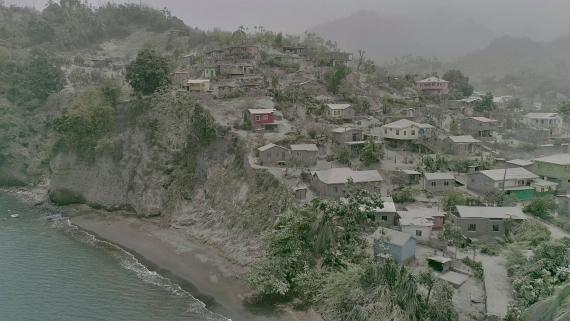
St. Vincent and the Grenadines
The landscape of St. Vincent and the Grenadines is shrouded in the ash blanket from the eruptions of the La Soufrière volcano that started explosively erupting on 9th April 2021, forcing some 16,000 residents to evacuate their homes to cruise ships and safer parts of the island.
UN NewsCERF allocates $1.5 million in response to the arrival of CAR refugees in DRC. Responding to the arrival of refugees from CAR to the DRC, ERC Lowcock allocated $1.5 million to provide urgent humanitarian assistance. Since December 2020, DRC has witnessed the arrival of refugees in the aftermath of election-related violence in CAR. Authorities had initially recorded some 92,000 refugees, with another 21,000 people having arrived during two weeks in late March and early April. Many of the refugees are living in dire conditions in remote, hard-to-reach areas without basic shelter and facing acute food shortages. The most urgent needs include food, water, sanitation, shelter, health care, core relief items, livelihoods, and protection to prevent spread of diseases, including COVID-19. With the CERF allocation, the Humanitarian Country Team proposes to focus on providing an integrated package of humanitarian assistance and protection.
CERF allocates $15 million to combat food insecurity in Afghanistan. ERC Lowcock allocated $15 million from CERF for an urgent response to food insecurity in Afghanistan. Severe shortfalls in precipitation over recent months have significantly affected agriculture and access to water, leading to increases in food insecurity and malnutrition. This situation has compounded other challenges, including intensifying conflict, new and protracted internal displacement, and ongoing COVID-19 challenges. With 16.9 million people already projected to be food insecure, the situation is expected to be further exacerbated by La Niña-driven drought-like conditions. At the same time, a water scarcity crisis is unfolding, impacting up to 2.4 million people. Responding to some of the most urgent needs of affected people, funds from CERF will enable agencies to provide assistance in the WASH, Health, Agriculture and Nutrition sectors, thus preventing a further deterioration of the humanitarian situation.
-
CBPFs disbursed $10.1 million to humanitarian partners in six countries in April 2021. Of this amount, around 94 per cent went to NGOs, including $6.4 million to 15 local and national partners and $2.4 million to international NGOs. CBPF funds targeted approximately 500,000 million people, of whom approximately 57 per cent were women and girls.
CBPFs continue to be the largest direct source of funding for local and national partners on the front lines of emergency response. From allocations launched in 2021, 45 per cent of CBPF funding was provided to national and local NGOs, including $300,000 received as sub-implementing partners of other organizations. CBPFs will continue to provide significant funding to local partners in 2021, leveraging their proximity to affected people and harnessing their local knowledge and social networks.
As of 30 April, donors had pledged or contributed $437 million to OCHA-managed CBPFs, including the top three fund recipients: Syria Cross-border, Yemen and Afghanistan. This is a significant increase from the $142 million recorded as of last month and the funds will contribute new and/or larger allocations being launched in the coming months.
Disbursement per Pooled Fund
Disbursements per type of recipient organization
Six CBPFs launched allocation rounds in April:
Ethiopia Humanitarian Fund (HF): $45 million standard allocation to support partners delivering the critical priorities outlined in the forthcoming HRP, particularly in the conflict-affected region.
Iraq HF: $13.5 million standard allocation to support partners responding to the needs of displaced communities and returnees, particularly in underserved location and focusing on primary health and WASH services, as well as livelihood support.
Nigeria HF: $4 million reserve allocation to deliver integrated education, nutrition, and protection services to vulnerable and crisis-affected children and adolescents in Borno, Adamawa and Yobe States.
Syria Cross Border HF: $8 million reserve allocation to scale up preparedness and preposition assistance, complementing other allocations that focus on services and assistance delivery; $85 million standard allocation to deliver a multi-sector response based on strategic priorities outlined in the 2021 Needs and Response Summary.
Ukraine HF: $1.5 reserve allocation to support partners’ response to urgent needs in both Non-Government Controlled Areas (NGCA) and Government Controlled Areas (GCA).
Sudan HF: $300,000 reserve allocation to support the timely scale up of isolation and treatment centers for people affected by COVID-19. As of 30 April, donors had pledged or contributed $437 million to OCHA-managed CBPFs, including the top three fund recipients: Syria Cross-border, Yemen and Afghanistan. This is a significant increase from the $142 million recorded as of last month and the funds will contribute new and/or larger allocations being launched in the coming months.
Allocations per Pooled Fund
Allocations per type of recipient organization
Tackling food insecurity
CBPFs are making strong contributions to address the current food security crisis and threat of famine in several countries. In 2020, CBPFs allocated $157 million to partners addressing food insecurity, the second largest sector funded by CBPFs after health, and an additional $61 million to partners delivering life-saving nutrition support to malnourished children and adults. Projects in other sectors, such as livelihoods, also assist people facing food insecurity and difficult times. For example, Halimo Ahmed is a 35-year-old mother of nine who lives in an IDP camp in Ainabo, Somalia. Before moving to the camp, Halimo’s family lost their sheep, goats, camels and a donkey. Being the sole breadwinner in the family, Halimo began selling milk and vegetables at a kiosk. She received a small-scale grant through a CBPF project to construct a better kiosk and buy more stock. “The fund helped me expand my business and I can now provide better for my family”, said Halimo.
In 2021, allocations have been made to partners tackling food insecurity in different contexts. For example, the Somalia HF provided $200,000 to AADSOM (Action Against Disasters Somalia) to deliver urgent food assistance and support livelihood recovery to affected communities in Hiran region. In total, Somalia HF already granted $600,000 to local and national partners to address urgent food and nutrition needs in different underserved localities, with a special focus on young children, girls, and pregnant, lactating women. The Syria HF has provided $700,000 to UNRWA to scale up food assistance to vulnerable Palestinian refugees in rural Damascus.
Multiple projects with large food security and nutrition components are currently under review, in particular in Somalia, Syria Cross Border, Venezuela and Sudan.
References
- Four plans are still pending finalisation: Ethiopia HRP, Pakistan HRP, Syria HRP, and Venezuela HRP.
- Other humanitarian funding includes funding for the Red Cross / Red Crescent Movement, in-kind assistance, bilateral funding, and others.
- https://docs.wfp.org/api/documents/WFP-0000125170/download/?_ga=2.53854056.1598936690.1620050280-17376482.1576272458
- https://fscluster.org/news/global-food-security-cluster-statement
- For more information on these anticipatory action allocations, see: Central Emergency Response Fund supports anticipatory action in Ethiopia and Somalia
- The number of people targeted and reached may include double counting as some people may receive assistance from multiple projects and/or organizations.

